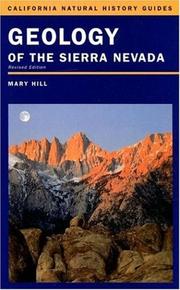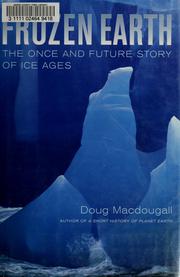| Listing 1 - 3 of 3 |
Sort by
|

ISBN: 9780520936942 9786612762833 0520936949 0520236955 9780520236950 0520236963 9780520236967 1282762834 9781282762831 Year: 2006 Publisher: Berkeley : University of California Press,
Abstract | Keywords | Export | Availability | Bookmark
 Loading...
Loading...Choose an application
- Reference Manager
- EndNote
- RefWorks (Direct export to RefWorks)
Writing with verve and clarity, Mary Hill tells the story of the magnificent Sierra Nevada-the longest, highest, and most spectacular mountain range in the contiguous United States. Hill takes us from the time before the land which would be California even existed, through the days of roaring volcanoes, violent earthquakes, and chilling ice sheets, to the more recent history of the Sierra's early explorers and the generations of adventuresome souls who followed. The author introduces the rocks of the Sierra Nevada, which tell the mountains' tale, and explains how nature's forces, such as volcanic eruptions, earthquakes, faulting, erosion, and glaciation formed the range's world-renowned scenery and mineral wealth, including gold. For thirty years, the first edition of Geology of the Sierra Nevada has been the definitive guide to the Sierra Nevada's geological history for nature lovers, travelers, hikers, campers, and armchair explorers. This new edition offers new chapters and sidebars and incorporates the concept of plate tectonics throughout the text. * Written in easy-to-understand language for a wide audience. * Gives detailed information on where to view outstanding Sierra Nevada geology in some of the world's most beloved natural treasures and national parks, including Yosemite. * Provides specific information on places to see glaciers and glacial deposits, caves, and exhibits of gold mines and mining equipment, many from Gold Rush times. * Superbly illustrated with 117 new color illustrations, 16 halftones, 39 line illustrations, and 12 maps, and also features an easy-to-use, interactive key for identifying rocks and a glossary of geological terms.
Geology --- Geognosy --- Geoscience --- Earth sciences --- Natural history --- Sierra Nevada (Calif. and Nev.) --- Sierra Nevada Mountains (Calif. and Nev.) --- Sierra Nevada Range (Calif. and Nev.) --- Sierras (Calif. and Nev.) --- Geology -- Sierra Nevada (Calif. and Nev.). --- Sierra Nevada (Calif. and Nev.). --- california. --- campers. --- earth sciences. --- earthquakes. --- easy to read. --- erosion. --- field guide. --- geologists. --- geology textbooks. --- glaciation. --- gold rush. --- gold. --- hikers. --- illustrated. --- maps. --- mineral deposits. --- mountain range. --- national parks. --- natural forces. --- natural history. --- natural sciences. --- natural world. --- nature lovers. --- nonfiction. --- plate tectonics. --- regional geology. --- regional history. --- rock science. --- scientists. --- sierra nevada. --- travel guide. --- travelers. --- united states. --- volcanic regions. --- yosemite.

ISBN: 0520954947 9780520954946 1299051588 9781299051584 9780520239227 0520239229 0520248244 9780520248243 0520275926 9780520275928 0520239229 9780520248243 9780520275928 Year: 2013 Publisher: Berkeley : University of California Press,
Abstract | Keywords | Export | Availability | Bookmark
 Loading...
Loading...Choose an application
- Reference Manager
- EndNote
- RefWorks (Direct export to RefWorks)
In this engrossing and accessible book, Doug Macdougall explores the causes and effects of ice ages that have gripped our planet throughout its history, from the earliest known glaciation-nearly three billion years ago-to the present. Following the development of scientific ideas about these dramatic events, Macdougall traces the lives of many of the brilliant and intriguing characters who have contributed to the evolving understanding of how ice ages come about. As it explains how the great Pleistocene Ice Age has shaped the earth's landscape and influenced the course of human evolution, Frozen Earth also provides a fascinating look at how science is done, how the excitement of discovery drives scientists to explore and investigate, and how timing and chance play a part in the acceptance of new scientific ideas. Macdougall describes the awesome power of cataclysmic floods that marked the melting of the glaciers of the Pleistocene Ice Age. He probes the chilling evidence for "Snowball Earth," an episode far back in the earth's past that may have seen our planet encased in ice from pole to pole. He discusses the accumulating evidence from deep-sea sediment cores, as well as ice cores from Greenland and the Antarctic, that suggests fast-changing ice age climates may have directly impacted the evolution of our species and the course of human migration and civilization. Frozen Earth also chronicles how the concept of the ice age has gripped the imagination of scientists for almost two centuries. It offers an absorbing consideration of how current studies of Pleistocene climate may help us understand earth's future climate changes, including the question of when the next glacial interval will occur.
Glacial epoch. --- Global environmental change. --- Paleoclimatology. --- Geology --- Earth & Environmental Sciences --- Stratigraphy --- Epoque glaciaire --- Paléoclimatologie --- Changement global (Environnement) --- Glacial epoch --- Paleoclimatology --- Global environmental change --- Geologic climate --- Palaeoclimatology --- Paleoclimate --- Climatic changes --- Climatology --- Ice Age --- Geology, Stratigraphic --- Environmental change, Global --- Global change, Environmental --- Global environmental changes --- Change --- Ecology --- 551.4 --- biographical chapters. --- biology. --- cataclysmic floods. --- climate and disaster. --- climate change. --- climate. --- climatology. --- earth sciences. --- ecology. --- engaging. --- environment. --- environmental changes. --- geography. --- geology. --- glacial interval. --- glaciation. --- history. --- human evolution. --- human migration. --- ice age. --- marine and oceanic. --- nasa. --- natural history. --- natural sciences. --- nature. --- oceanography. --- paleontology. --- phenomenon. --- planetary science. --- pleistocene ice age. --- pleistocene. --- popular science. --- prehistory. --- science and math. --- science. --- snowball earth. --- weather.
Book
Year: 2020 Publisher: Basel, Switzerland MDPI - Multidisciplinary Digital Publishing Institute
Abstract | Keywords | Export | Availability | Bookmark
 Loading...
Loading...Choose an application
- Reference Manager
- EndNote
- RefWorks (Direct export to RefWorks)
This Special Issue comprises 12 papers from authors in 10 countries with new insights on the close coupling between magma as an energy and fluid source with hydrothermal systems for the primary control of magmatic behavior. Data and interpretation are provided on the rise of magma through a hydrothermal system, the relative timing of magmatic and hydrothermal events, the temporal evolution of supercritical aqueous fluids associated with ore formation, the magmatic and meteoric contributions of water to the systems, the big picture for the highly active Krafla Caldera, Iceland, as well as the implications of results from drilling at Krafla concerning the magma–hydrothermal boundary. Some of the more provocative concepts are that magma can intrude a hydrothermal system silently, that coplanar and coeval seismic events signal “magma fracking” beneath active volcanoes, that intrusive accumulations may far outlast volcanism, that arid climate favors formation of large magma chambers, and that even relatively dry rhyolite magma can rapidly convect and so lack a crystallizing mush roof. A shared theme is that hydrothermal and magmatic reservoirs need to be treated as a single system.
la soufrière --- guadeloupe --- volcanic gas --- volcanic unrest --- hydrothermal gas --- multigas --- extensometry --- Krafla volcano --- geothermal systems --- conceptual models --- volcanology --- magma --- hydrothermal --- fracking --- volcanoes --- Kamchatka --- igneous petrology --- tectonics --- heat flow --- glaciation --- climate --- incremental pluton emplacement --- contact metamorphism --- petrochronology --- titanite --- zircon --- U-Pb dating --- thermometry --- hydrothermal fluids --- incremental intrusion --- hydrothermal fluid --- microstructure --- dissolution --- precipitation --- textural coarsening --- alteration --- porosity --- eruption --- fracture --- permeability --- dome emplacement --- hydrothermal system --- RSAM --- tremor --- gliding spectral lines --- White Island --- phreatic eruptions --- geyser --- Uzon --- CO2 --- TOUGH2 --- modeling --- Kirishima volcano group --- Ebinokogen Ioyama volcano --- geothermal activity --- multiple hydrothermal system --- magmatic hydrothermal eruption --- kick upwelling --- Erdenet Cu–Mo deposit --- cathodoluminescence --- supercritical fluid --- transient fluid pressure --- magmatic-hydrothermal system --- fluid inclusion --- magma energy --- magma convection --- heat flux --- geothermal energy --- magma–hydrothermal --- heat transport --- gas and fluid geochemistry --- phreatic eruption --- volcano monitoring --- geophysical imaging --- drilling
| Listing 1 - 3 of 3 |
Sort by
|

 Search
Search Feedback
Feedback About UniCat
About UniCat  Help
Help News
News